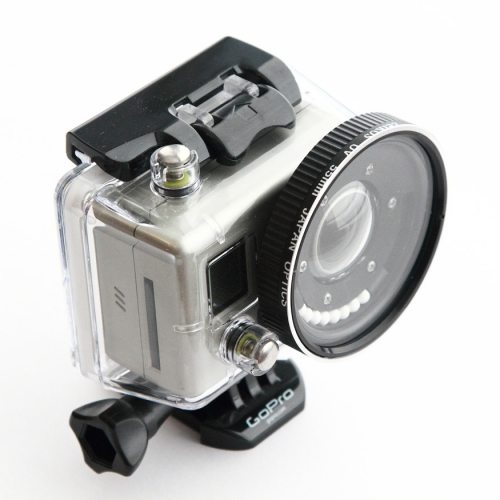 I’m really loving the GoPro2 HD Hero2; it’s wide angle 170° FOV lens and small size make it so versatile and handy, and it nicely compliments my “normal” camera gear. The waterproof housing supplied with it means it’s a robust little unit, and knowing that it’s waterproof to 60m gives you quite a bit of peace of mind when you’re out and about using it. That being said, the standard housing supplied with it has 3 main shortfallings:
I’m really loving the GoPro2 HD Hero2; it’s wide angle 170° FOV lens and small size make it so versatile and handy, and it nicely compliments my “normal” camera gear. The waterproof housing supplied with it means it’s a robust little unit, and knowing that it’s waterproof to 60m gives you quite a bit of peace of mind when you’re out and about using it. That being said, the standard housing supplied with it has 3 main shortfallings:
- The domed lenses lead to non-optimal (blurry) image quality while underwater.
- Enclose a warm electronic device into a sealed housing and you’ll potentially get condensation/fogging.
- The inability to run filters which can be used to compensate for colours underwater or for a Circular Polarizer (CPL) or Neutral Density (ND) filter.
My SCUBA diving days are pretty much over, and my GoPro will be used mainly for terrestrial purposes. The wide angle lens is fantastic for scenery, and one of the filters I think should be in any photographers kit from amateur up is a CPL (I”m certainly no professional, just an enthusiastic amateur 🙂 ). If you’re interested in use underwater there’s a ton of reviews available on YouTube, and though I have included a great underwater comparison at the bottom of the review, I’m going to concentrate more on use above water.
Snake River Prototyping (SRP) was good enough to send The Gadgeteer a review unit of their BlurFix, a third-party accessory custom made to address these three shortfallings of the GoPro Hero cameras but it’s not just useful underwater………..
What’s in the box?
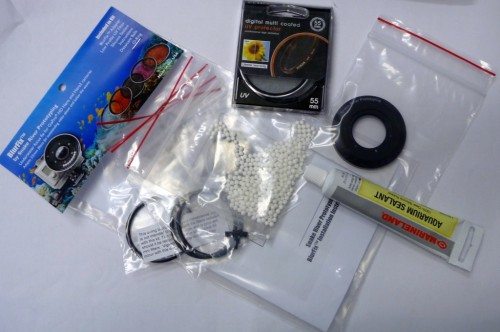 Everything you need is included in the BlurFix kit: the BlurFix adapter, 3 O-Rings, silicone sealant, desiccant (activated Aluminia), rubber stoppers and a 55mm UV filter. All you need to supply is a #0 Phillips screwdriver and something sharp like a toothpick or match to spread the silicone. SRP also sent me a ready-installed housing, another option you can get if you’re not confident with your skills or just too lazy to install it yourself. 🙂
Everything you need is included in the BlurFix kit: the BlurFix adapter, 3 O-Rings, silicone sealant, desiccant (activated Aluminia), rubber stoppers and a 55mm UV filter. All you need to supply is a #0 Phillips screwdriver and something sharp like a toothpick or match to spread the silicone. SRP also sent me a ready-installed housing, another option you can get if you’re not confident with your skills or just too lazy to install it yourself. 🙂
De-Installation
Most people do installation guides; however, I’m going to do the opposite. 🙂 Here’s a disassembly guide; it may be useful if you have a BlurFix that leaks and you have to redo the installation.
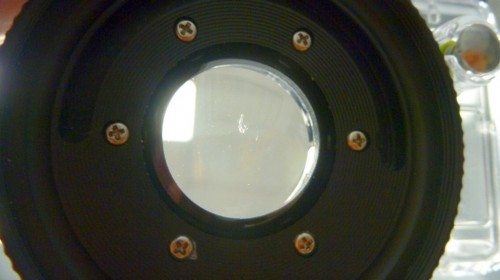 The pre-assembled BlurFix housing sent to me had a scratch on the lens when received, so I wanted to transfer the adapter to my existing housing.
The pre-assembled BlurFix housing sent to me had a scratch on the lens when received, so I wanted to transfer the adapter to my existing housing.
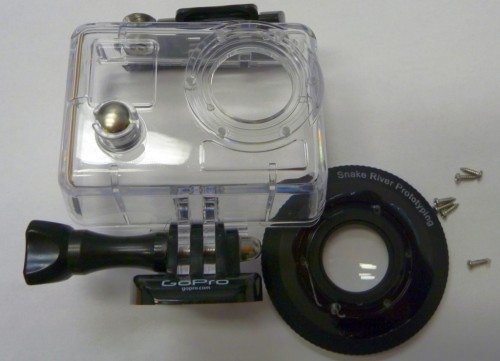 Remove the six screws and gently pry the BlurFix off. Use a good quality, long handled screwdriver, as this will make the job so much easier and reduce the chances of stripping the heads of the screws. The silicone shouldn’t cause any issue here, and you shouldn’t need to use too much force to get the adapter off the housing.
Remove the six screws and gently pry the BlurFix off. Use a good quality, long handled screwdriver, as this will make the job so much easier and reduce the chances of stripping the heads of the screws. The silicone shouldn’t cause any issue here, and you shouldn’t need to use too much force to get the adapter off the housing.
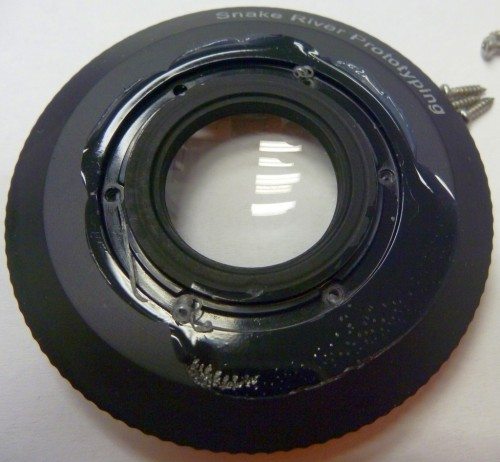 You can see the silicone on the adapter. It’s worth noting that the silicone doesn’t have anything to do with the waterproof integrity of the housing. Because you leave the original o-ring and lens in place, all the silicone does is stop water from getting between the BlurFix and the housing.
You can see the silicone on the adapter. It’s worth noting that the silicone doesn’t have anything to do with the waterproof integrity of the housing. Because you leave the original o-ring and lens in place, all the silicone does is stop water from getting between the BlurFix and the housing.
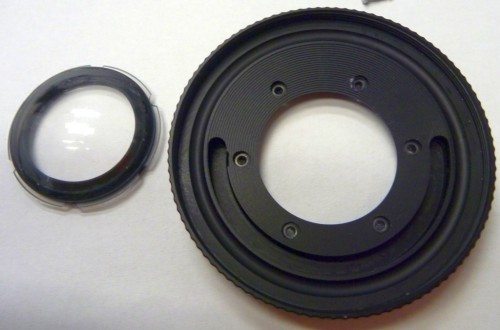 Push the lens out of the adapter. It shouldn’t take too much pressure.
Push the lens out of the adapter. It shouldn’t take too much pressure.
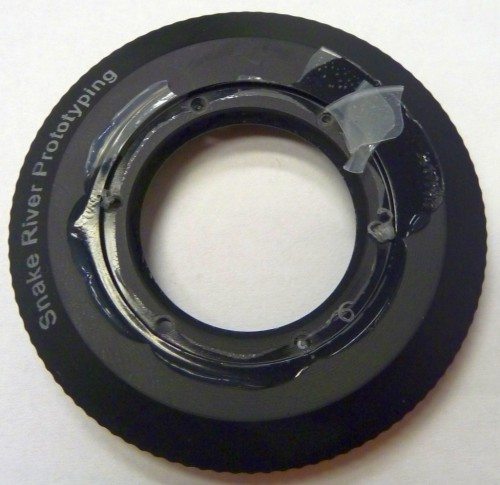 Just use your fingernail and scrap off all the silicone on the adapter.
Just use your fingernail and scrap off all the silicone on the adapter.
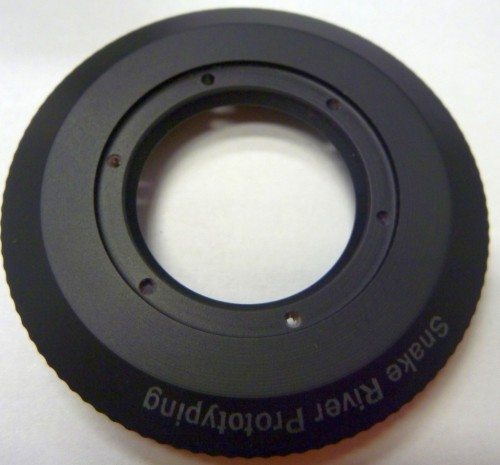 And you’ll end up with a brand new BlurFix ready for reinstallation. 🙂 The BlurFix ring is made of CNC machined anodized aluminum, and it fits perfectly around the ferrule of the existing housing. The black anodized finish eliminates any reflections you would get off the adapter. You can certainly tell that it’s a quality piece of equipment and a lot of care has gone into making it.
And you’ll end up with a brand new BlurFix ready for reinstallation. 🙂 The BlurFix ring is made of CNC machined anodized aluminum, and it fits perfectly around the ferrule of the existing housing. The black anodized finish eliminates any reflections you would get off the adapter. You can certainly tell that it’s a quality piece of equipment and a lot of care has gone into making it.
Installation
For those who can’t think backwards, rather than post pictures of installation, here’s the installation video from Snake River Prototyping.
Things I’d take note of are:
- Use a good quality #0 Phillips head screwdriver (a jeweler’s one with the rotating head is a good option)
- Don’t use too much silicone
- Don’t get any silicone on the lens
- Check the silicone through the back of the case when you’re finished
- Do up the screws as suggested in the manual, like you would a car wheel (opposites)
- Don’t over tighten the screws; you don’t want to strip the thread on the housing as it’s only plastic
- Test your installation underwater WITHOUT the camera inside the housing 🙂
Because I was only going to use on land, I considered removing the standard plastic lens, reasoning that it was an additional layer to reduce the optics. Just to be safe I thought I’d better email SRP and got back the following reply:
“Our BlurFix uses the standard lens as support for the sealing connection and should not be removed during installation. Our setup is designed to work with the standard lens.”
Housing Comparison
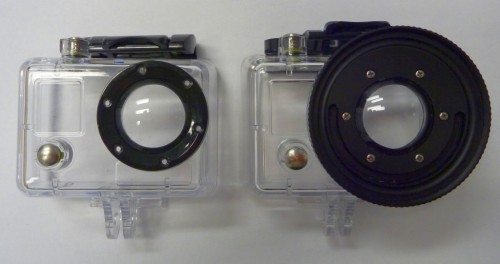
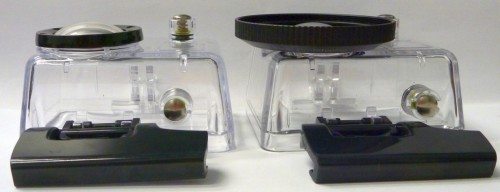 Here’s the housing before and after the BlurFix installation. You can see that the BlurFix does add some weight and bulk to the housing, but these are easily outweighed by the benefits. One thing to note is that the BlurFix does cover the front activity LED completely.
Here’s the housing before and after the BlurFix installation. You can see that the BlurFix does add some weight and bulk to the housing, but these are easily outweighed by the benefits. One thing to note is that the BlurFix does cover the front activity LED completely.
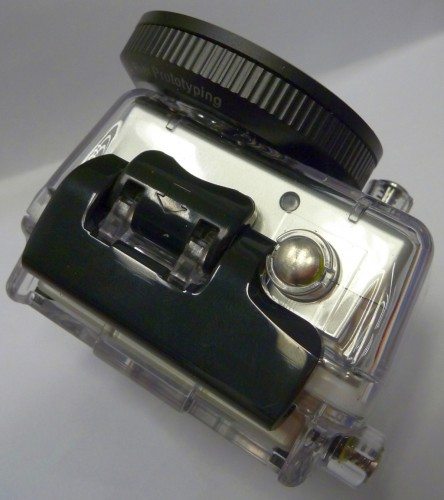
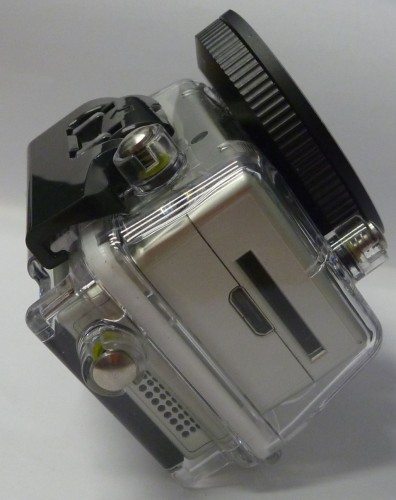 For such a small camera, this just keeps getting bigger and bigger. Here’s my setup now with LCD BacPac and BlurFix with UV Filter. Still small enough to be pocketable, but getting heavier. If only it didn’t have that beautiful wide angle lens…… 🙂
For such a small camera, this just keeps getting bigger and bigger. Here’s my setup now with LCD BacPac and BlurFix with UV Filter. Still small enough to be pocketable, but getting heavier. If only it didn’t have that beautiful wide angle lens…… 🙂
Filters
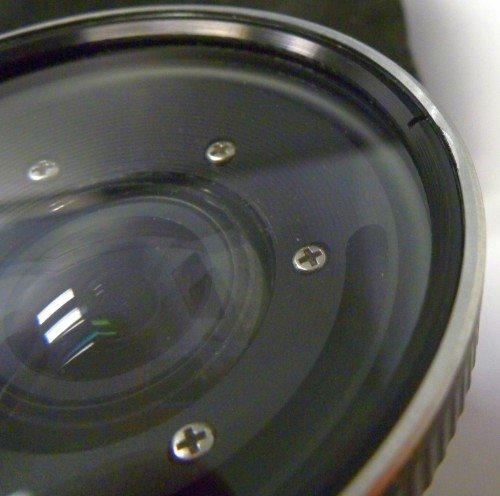 The BlurFix allows you to add any 55mm filter to your GoPro, but to reduce the vignetting, you’re best to use a low profile filter. SRP supplies filters that are modified by grinding the front the ring down to reduce vignetting. This does remove the front thread on the filters, so stacking of filters is not allowed; however ,with the wide angle on the Hero2, stacking filters would only increase the vignetting anyway.
The BlurFix allows you to add any 55mm filter to your GoPro, but to reduce the vignetting, you’re best to use a low profile filter. SRP supplies filters that are modified by grinding the front the ring down to reduce vignetting. This does remove the front thread on the filters, so stacking of filters is not allowed; however ,with the wide angle on the Hero2, stacking filters would only increase the vignetting anyway.
Available from SRP are:
- Cyan for blue-green tropical fresh and salt water
- Green for green algae fresh and saltwater
- Cyan Shallow for blue-green tropical fresh and salt water up to 25m
- Circular Polarizer
- UV Clear – supplied with BlurFix kit.
Vignetting
SRP send me the following “warning” about vignetting. Something to keep in mind.
” We originally created the BlurFix for the Hero (1) last May. Vignetting in 480, 720p, and 1080p mode was never an issue with that camera. When the Hero2 came out last October we were relieved the housing remained the same, however, some Hero2 cameras do experience vignetting in 2 corners for above water applications with the filter installed in WIDE modes in these resolutions. Below water, this mechanical vignetting usually disappears due to the magnification introduced by the water. As you have above water plans for the camera I wanted you to be aware of this. Most Hero2 cameras do not vignette — but some do. It’s an alignment tolerance issue with the camera lens itself as it typically occurs independent of the housing. With the Hero or Hero2 vignetting will occur in 960p WIDE and photo modes. ”
Because my unit isn’t going underwater a majority of the time, I am just using the BlurFix and a filter, no desiccant or O-ring. This reduces the vignetting as much as possible. Of course if I ever need to use underwater, it’s just a matter of quickly installing the desiccant and O-ring and down, down, down I go. Conversion back to land is an easy job too.
So what does a Circular Polarizing filter do? In the above video, watch the glare on the window on the right hand side and also the cloud definition on the left hand side. The nice thing for me is that a CP filter will make clouds “pop”. I don’t do any post processing of my photos, so using the CP filter lets me “optimise” my photos while I’m taking them.
A few things to take note of when using the BlurFix with a CP filter on the GoPro:
- Notice in the video how the microphone is picking up the “grinding” as you adjust the CP filter, not much you can do about that.
- Because of the wide angle on the lens, you have to be very careful where you hold the CP filter while you’re adjusting it, otherwise you’ll get fingers in your video or photos
- A CP filter will reduce the amount of light getting to your camera’s sensor ,and so it will have to compensate by raising the ISO (which can be an advantage, and you can actually use your CP filter as a ND filter)
- To see the effect of the CP filter and to ensure that you’re getting the maximum effect, you really do require the LCD BacPac to visually confirm. Even using the LCD, because it’s only 2″, you need to concentrate on one area of the screen to see what’s going on. Not easy in some light conditions, but much easier than with no LCD. 🙂
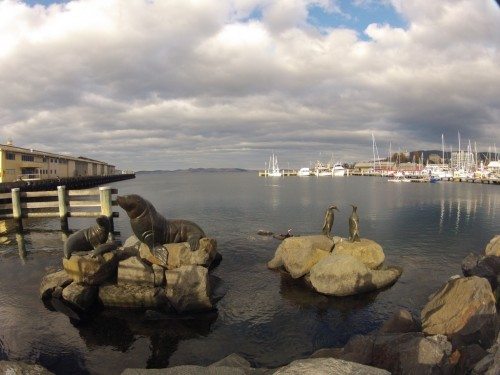
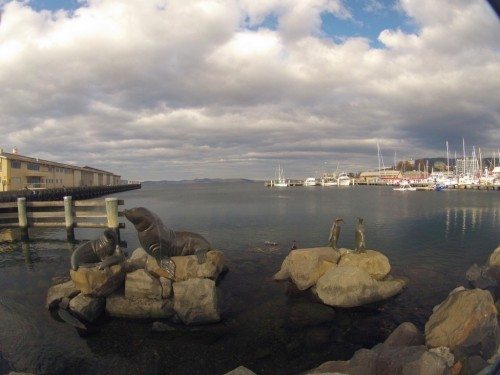
If you click on the pictures taken in 11MP wide-mode above, you can see the difference the CP filter can make. The first thing to notice is the reflections off the sculptures; the CP filter takes glare off the bronze. If you look at the water in front of the sculptures, the CP filter means that you can actually see the rocks under the water now the glare has been taken away. In both the above photos, you can just see some vignetting on the top right hand corner, slightly more with the CP filter installed.
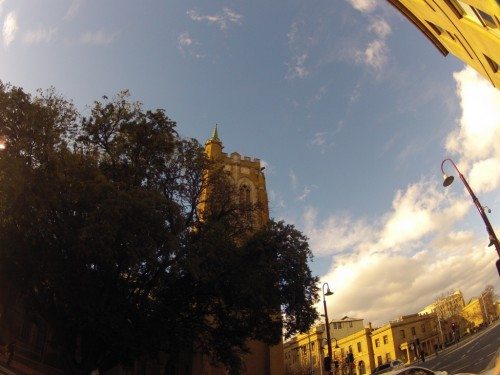
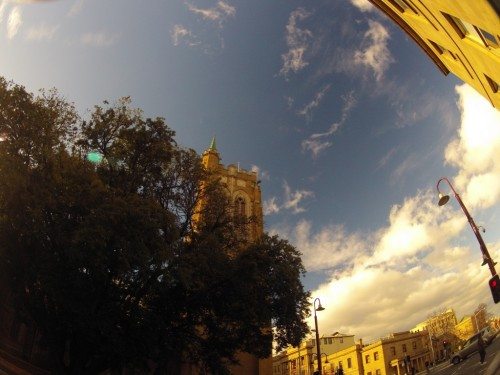
Checkout the extra definition you get with the clouds in the picture above especially the wispy ones. CP filters are great for cloud pictures. Again there’s some very slight vignetting in the top right corner, but not enough to worry about. See that building in the top right hand corner? That building is actually behind me. The wide angle lens strikes again.
Effect underwater
Since I’m getting too old and unfit to dive the freezing cold waters of Tasmania these days :), here’s a great video from fellow Aussie martcerv comparing the blurry effect of the standard housing underwater versus the BlurFix and also the effect of using a cyan filter underwater. (Video used with permission).
Other Comments
Because of the scratch in the lens in the pre-built housing, I got into some email correspondence with SRP. The responsiveness, willingness to help, service and advice that came back was fantastic. Again I think this is another example of how “smaller operators” still care about their products and customers. This is something that a lot of larger organizations should take note of.
Conclusion
While you’ll find the BlurFix primarily discussed on scuba sites, it can be used just as effectively by the land-based GoPro user.
Whether you’re doing landscapes or using in glary conditions where there’s snow, sand or water, the BlurFix allows you to use any 55mm filter that will allow you to compensate for those conditions. Sure, a lot of special effects these days can be done in post processing of your photos, but I’m too lazy to learn how or to actually do this. And the effect that a circular polarizer gives you is one effect that can’t be emulated in post processing.
If used in rugged conditions, using the supplied UV protector lens will give the standard housing lens another layer of protection, though it is worth noting that the UV lens supplied with the standard kit is glass, not plastic. That’s good for the optics, but bad if it gets hit by a rock or similar. 🙂
Don’t dismiss the BlurFix on your GoPro just because you’re going to only use it above water. The additional bulk and weight may put a few people off installing the BlurFix, but for me the added flexibility when using on land, and potentially underwater, outweighs these factors.
SD Card Reader for iPhone iPad, Oyuiasle Digital Trail Camera SD Card Viewer with Dual Slot for MicroSD/SD, Lightening&USBC Dual-Connector Memory Card Adapter for Photography, Plug and Play
47% OffAltura Photo Camera Cleaning Kit - Camera Accessories Electronics Bundle - Lens Cleaner Spray, Brush, Pen, Cloths, Wipes, Air Blower - DSLR Photography Accessories Lens Cleaning Kit Photographer Gifts
32% OffProduct Information
| Price: | $77 for BlurFix kit, $139 for BlurFix pre-installed to a housing, and $77 - $99 for filters |
| Manufacturer: | Snake River Prototyping |
| Requirements: |
|
| Pros: |
|
| Cons: |
|



Gadgeteer Comment Policy - Please read before commenting
None of the dome mods were actually necessary. People without much optical knowledge hacked these dome-housings. GoPro themselves didn’t initially offer a solution either until they understood the problem much later.
The solution is: a) either unscrew the lens slightly (at your own peril), so that it focuses closer natively, or b) slip a +4 diopter between the original camera lens and the dome if you can fit it. The newer Hero3 and 4 don’t have that problem as they can focus more closely.